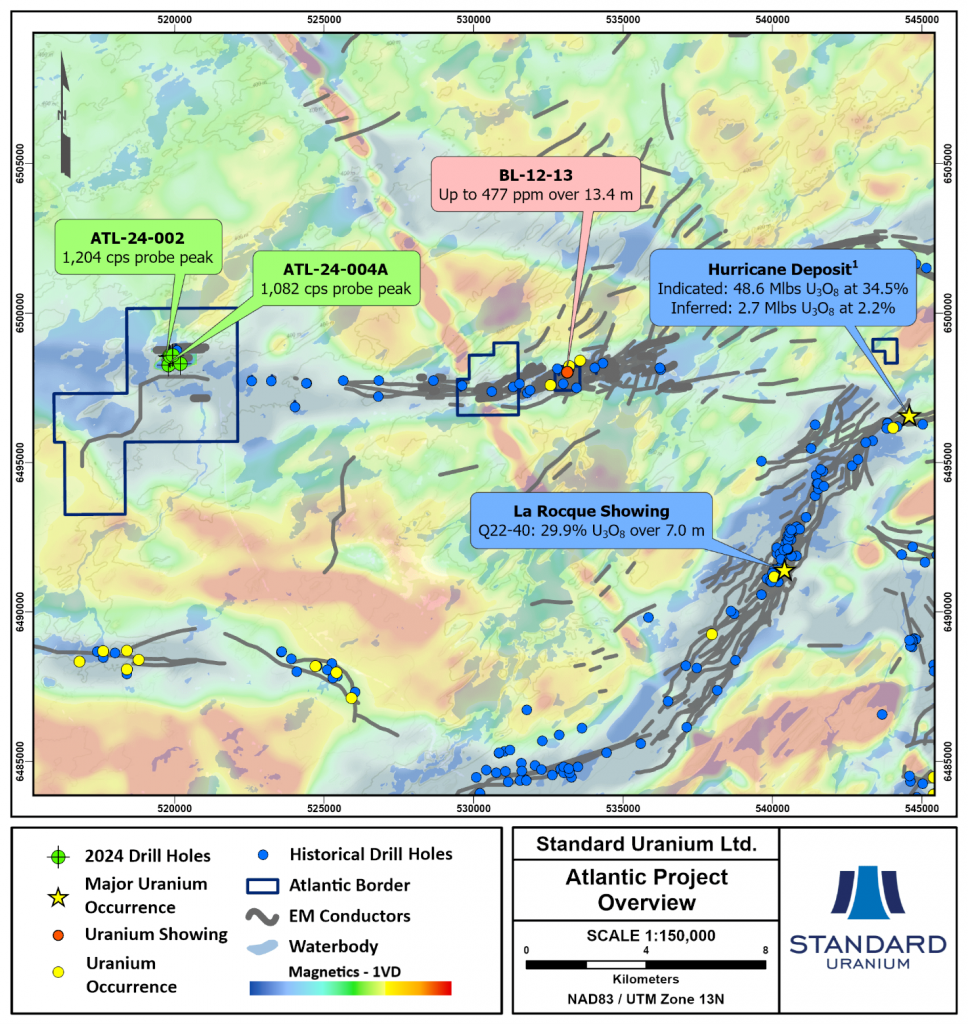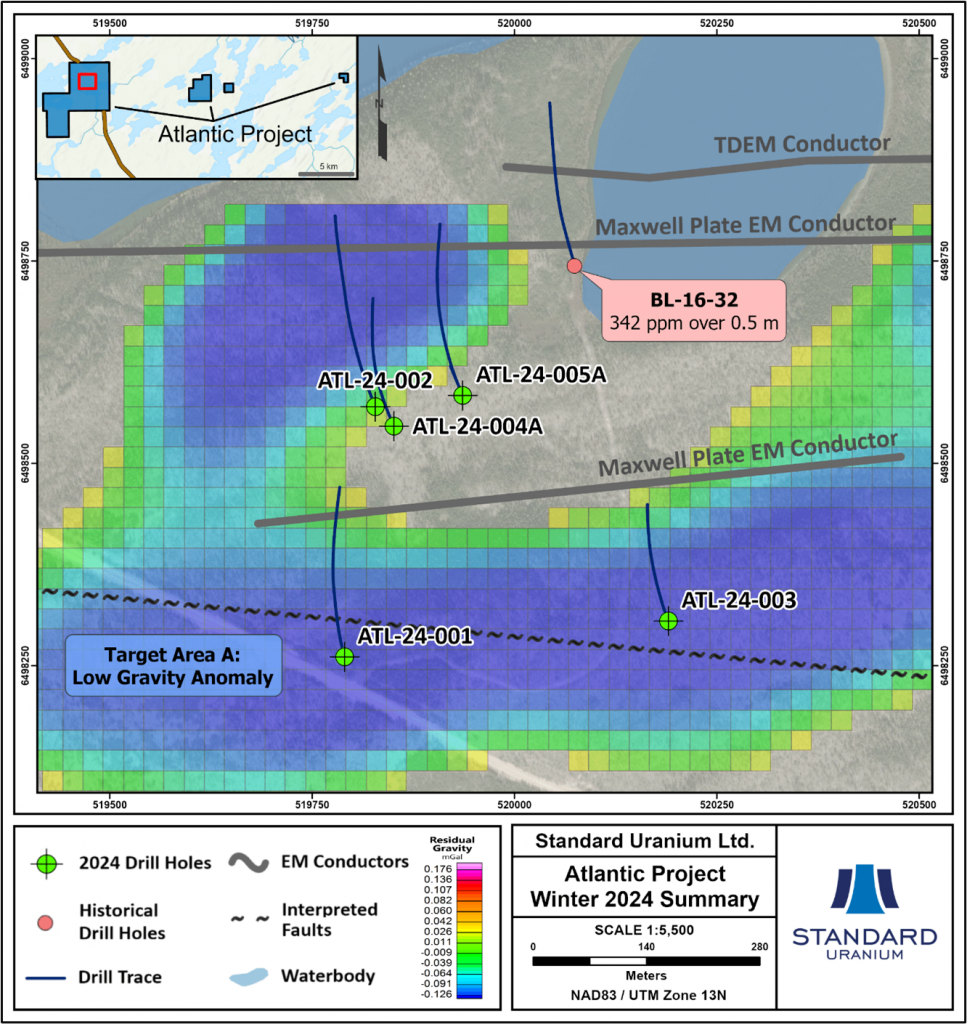
Standard Uranium (TSXV:STND) has recently completed its first round of drilling at the Atlantic Project, located in the eastern Athabasca Basin, northern Saskatchewan. The project spans over 3,061 hectares and initial reports indicate that all drill holes showed signs of anomalous radioactivity. This area is known for its uranium potential, hosting numerous occurrences of the element along an 18 km east-west trending conductive exploration trend.
Sean Hillacre, Standard Uranium’s VP of Exploration, commented in a press release: “Intersecting anomalous radioactivity across all five drill holes targeting a completely untested area on the Atlantic project is extremely encouraging. The results from this program have confirmed the presence of a significant structural framework on the property providing the ideal conditions for high-grade unconformity-related uranium mineralization. The scale and intensity of deformation in the basement rocks we drilled this season is highly prospective and paired with the radioactivity and hydrothermal alteration intersected in the overlying sandstone, we are just in the beginning of uncovering the compelling story on the first of many target areas on Atlantic.”
The drilling was part of a partnership with ATCO Mining Inc., which holds the option to acquire a 75% interest in the Atlantic Project over the next three years. This recent drilling activity is part of the effort to meet the first year’s minimum exploration expenditure as required under the terms of the option agreement.
In 2022, a detailed ground gravity survey was conducted on the western portion of the claim block, which identified multiple subsurface density anomalies. These anomalies suggest the presence of significant hydrothermal alteration zones, potentially important for uranium deposition. These findings led to the targeted drilling activities this winter.
The drill program specifically aimed to follow up on findings from a 2016 drill hole by Denison Mines, which had identified significant uranium mineralization. This winter’s drilling focused on a region defined by a large density-low anomaly, which coincides with electromagnetic (EM) conductors and a regional fault, all suggesting a highly prospective target area for uranium.
The samples collected from the drilling have been sent to SRC Geoanalytical Laboratories in Saskatoon for a comprehensive range of tests including multi-element analysis and uranium assays. The laboratory, recognized for its adherence to international standards, also tested for additional elements like boron and performed specialized assays to determine the uranium content directly.
To ensure the accuracy and reliability of the assay results, Standard Uranium implemented rigorous quality assurance and quality control measures, including the insertion of blanks, standard reference materials, and repeat samples into the testing sequence.
Moreover, samples showing clay alteration have been forwarded to Rekasa Rocks Inc. for advanced analysis using Short Wavelength Infrared Reflectance. This will help in identifying the specific types of clay minerals present, which is critical in understanding the geochemical environment of the uranium mineralization.
The results of these geochemical assays are eagerly awaited and will be disclosed following a detailed review by Standard Uranium’s technical team. This ongoing work at the Atlantic Project is a crucial step in exploring and potentially developing this promising uranium resource in Saskatchewan.
Neil McCallum, director of Standard Uranium and Atco Mining, also commented: “I am very encouraged with the magnitude of the structure and alteration that has been encountered thus far. Combined with the anomalous radioactivity, we’re setting the stage for more success on the project. We are already planning the next steps, so having this information will be an incredible addition to our exploration model.”

Highlights from the results are as follows:
- Inaugural Success: Anomalous radioactivity (>300 cps) was intersected in all five of the Company’s inaugural drill holes at the Atlantic Project, coinciding with prospective structural zones and favorable alteration including dravite-rich clays.
- Sandstone & Basement-Hosted Radioactivity: Multiple zones of elevated radioactivity linked to the sub-Athabasca unconformity and basement structural zones were intersected, indicating a uranium-fertile system.
- Verified Targets: Massive structural disruption confirmed in the sandstone column and multiple wide (>10 metres) brittle-reactivated graphitic shear zones confirm the main interpreted electromagnetic (“EM”) corridor on the western claim block which was not reached by previous operators. The inaugural program results have confirmed the Company’s exploration thesis on the Project, highlighting a uranium-fertile system with several kilometres of still untested strike length across the Project.
- Hydrothermal U Input: Uranium: Thorium (“U:Th”) ratios >3:1 measured with the handheld RS-125 Super-Spec suggest hydrothermal uranium input focused along structures.
- On Time & Under Budget: Completion of 3,316 metres within 5 drill holes, surpassing meterage expectations both on time and under budget.
- Follow Up Targets & Next Steps: Atlantic holds significant upside for discovery along the untested portions of the E-W conductor system. Supplementary geophysical surveys over the central claim blocks will provide further target areas for phase II and III drilling, along with the additional untested gravity low anomalies on the western block identified in 2022.
Table 1. Atlantic winter 2024 drill hole collar summary. Easting and Northing coordinates are reported in UTM Zone 13N, NAD83 datum; EOH = end of hole; m.a.s.l. = metres above sea level.
| DDH | Easting | Northing | Elevation (m.a.s.l.) | Azimuth (°) | Dip (°) | EOH (m) |
| ATL-24-001 | 519790 | 6498261 | 412 | 344.80 | -69 | 599 |
| ATL-24-002 | 519828 | 6498570 | 394 | 336.90 | -67 | 641 |
| ATL-24-003 | 520190 | 6498305 | 396 | 338.20 | -74 | 588 |
| ATL-24-004* | 519851 | 6498546 | 388 | 336.20 | -74 | 60 |
| ATL-24-004A | 519851 | 6498546 | 388 | 336.20 | -74 | 657 |
| ATL-24-005* | 519936 | 6498584 | 398 | 335.90 | -69 | 111 |
| ATL-24-005A | 519936 | 6498584 | 398 | 336.40 | -69 | 660 |
* Restarted due to difficult ground conditions.
Table 2. Atlantic winter 2024 drill hole radioactivity summary. Scintillometer readings are taken from down-hole depths, gamma probe peaks are corrected survey depths.
| DDH | From (m) | To (m) | Width (m) | Lithology | RS-125 Scintillometer | 32GR Gamma Probe | |||
| Min | Max | Avg. | Peak | Depth (m) | |||||
| ATL-24-001 | 520.5 | 521.0 | 0.5 | Sandstone | 170 | 360 | 265 | 337 | 518.55 |
| ATL-24-001 | 521.5 | 522.0 | 0.5 | 130 | 310 | 220 | |||
| ATL-24-001 | 523.5 | 524.0 | 0.5 | 160 | 340 | 250 | |||
| ATL-24-002 | 509.0 | 509.5 | 0.5 | Sandstone | 200 | 590 | 395 | 1,204 | 506.27 |
| ATL-24-003 | 505.0 | 505.5 | 0.5 | Sandstone | 160 | 280 | 220 | 323 | 506.59 |
| ATL-24-003 | 558.0 | 558.5 | 0.5 | Basement | 110 | 280 | 195 | ||
| ATL-24-004A | 530.0 | 530.5 | 0.5 | Basement | 100 | 560 | 330 | 1,082 | 530.18 |
| ATL-24-004A | 544.5 | 545.0 | 0.5 | 140 | 360 | 250 | |||
| ATL-24-004A | 550.0 | 550.5 | 0.5 | 140 | 370 | 255 | |||
| ATL-24-005A | 493.0 | 493.5 | 0.5 | Sandstone | 120 | 310 | 215 | 647 | 490.99 |
| ATL-24-005A | 494.5 | 495.0 | 0.5 | 180 | 450 | 315 | |||
| ATL-24-005A | 496.5 | 497.0 | 0.5 | 140 | 310 | 225 | |||



 Follow us on Twitter
Follow us on Twitter Become our facebook fan
Become our facebook fan










Comments are closed.